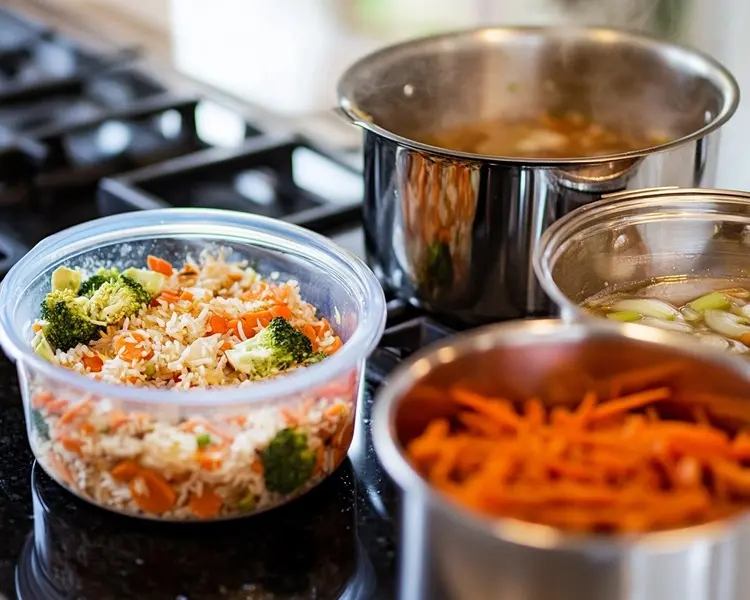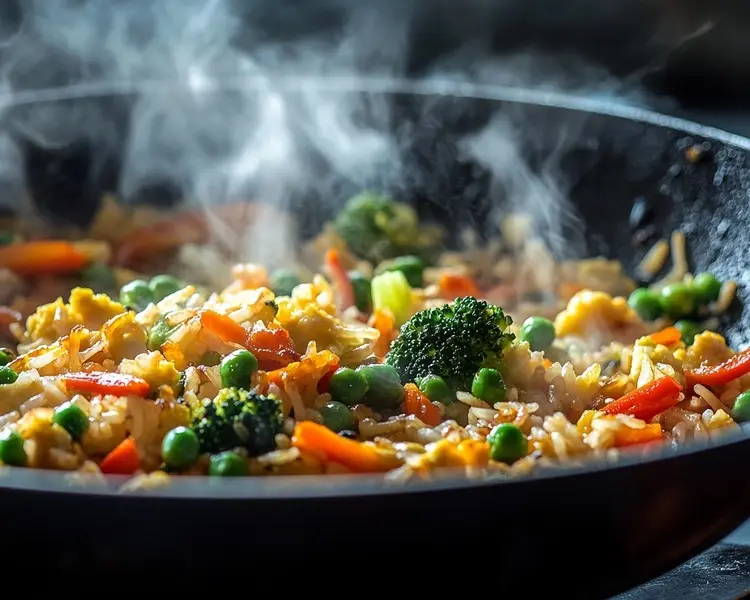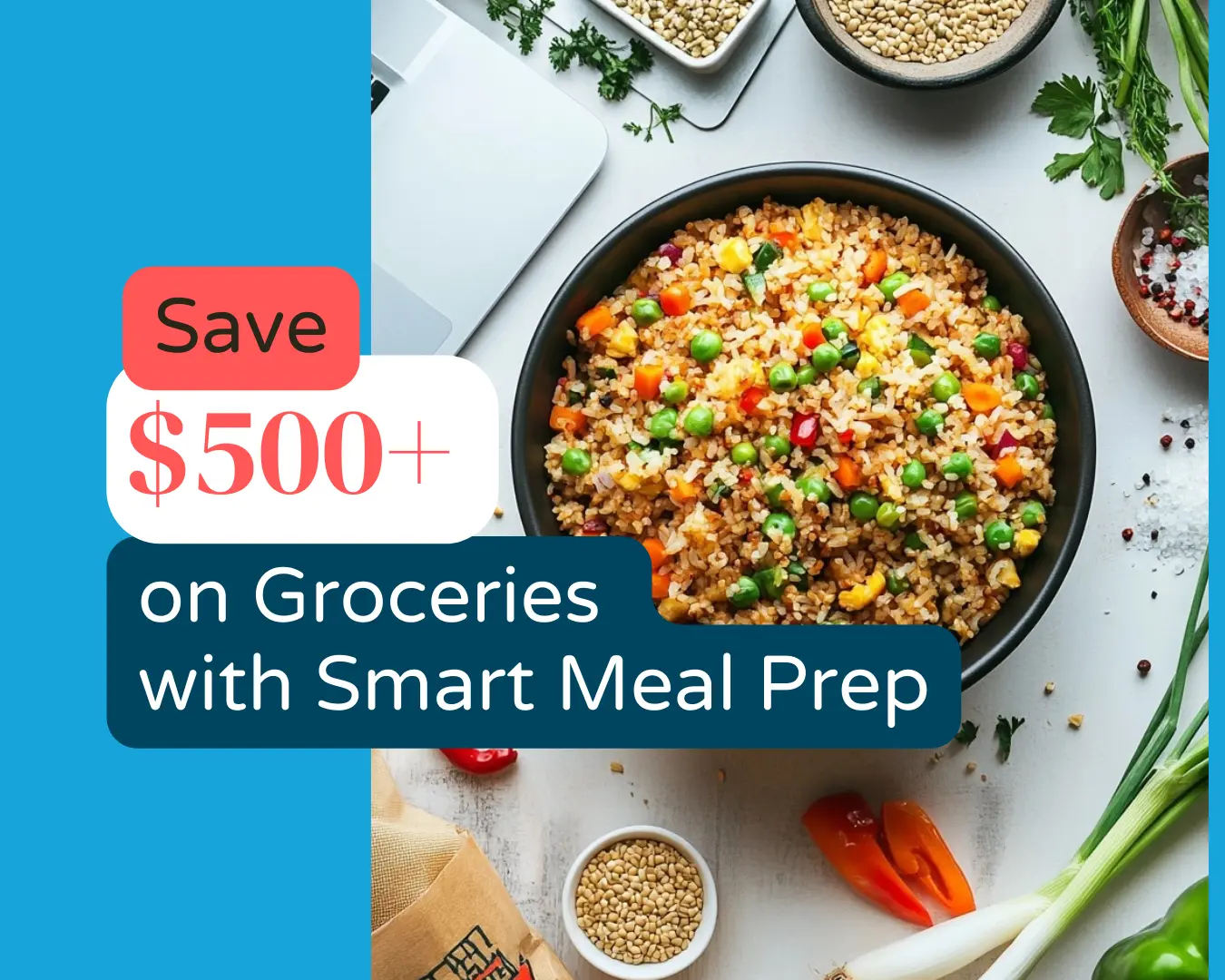The average family of four wastes over $1,800 on groceries annually. Budget meal prep doesn’t just save you time and reduce stress—it can significantly lower your grocery bills.
This comprehensive guide will help you implement smart shopping strategies that work perfectly with your meal prep system. By following these budget-conscious approaches, you’ll be able to enjoy nutritious, delicious meals all week without breaking the bank.
Table of Contents
My Shopping Transformation: Last year, I was spending nearly $250 weekly on groceries for my family, with almost a third ending up in the trash. After implementing these exact budget meal prep strategies, I’ve cut our grocery bill to $140 weekly while actually increasing meal quality. The systematic approach I’m sharing helped me save over $5,000 in just one year!
How to Save Money on Seasonal Spring Produce
Embrace seasonal abundance to keep costs down while enjoying peak freshness:
- Asparagus: Prices drop by up to 50% during peak spring season
- Spring greens: Look for spinach, arugula, and lettuce at their lowest prices of the year
- Strawberries: Buy in bulk during spring when prices dip and freeze extras for smoothies
- Fresh herbs: Start a small windowsill herb garden for continuous supply at a fraction of store prices
Shop with a Seasonal Mindset
- Check weekly supermarket flyers before meal planning to build your menu around discounted seasonal items
- Visit farmers’ markets in the late afternoon when vendors often reduce prices to avoid bringing produce back
- Join a CSA (Community Supported Agriculture) program for regular deliveries of seasonal produce at wholesale prices
Smart Shopping Habits That Save You Money
Before You Shop
- Inventory check: Audit your pantry, refrigerator, and freezer before planning
- Meal plan based on sales: Review store flyers and build your weekly menu around discounted items
- Create a detailed list: Organize by store section to prevent impulse purchases
- Eat before shopping: Shopping hungry leads to an average of 40% more food purchases
At the Store
- Shop the perimeter first: Focus on fresh foods before visiting processed food aisles
- Compare unit prices: Look at the price per ounce/pound, not just the package price
- Consider store brands: Save 20-30% with minimal quality difference for many items
- Buy whole foods: Pre-cut vegetables cost 40-100% more than whole ones
- Check clearance sections: Look for manager’s specials on items nearing their sell-by date
Regional Price Variations and Shopping Strategies
Grocery prices can vary significantly by region. Here’s how to maximize savings with budget meal prep, no matter where you live:
- Urban Areas: Focus on ethnic grocery stores which often offer produce, spices, and staples at lower prices than chain supermarkets. Take advantage of competitive pricing between multiple stores within short distances.
- Suburban Areas: Leverage price-matching policies at major chains and utilize loyalty programs which tend to be more robust in competitive suburban markets.
- Rural Areas: Consider bulk purchasing cooperatives with neighbors to achieve volume discounts. For fresh produce, explore direct-from-farm purchasing options which eliminate middleman costs.
- Coastal Regions: Seafood is often less expensive at local fish markets than inland. Conversely, save on produce by focusing on what’s grown locally rather than items that require long-distance shipping.
- Seasonal Adjustments: In northern regions, expect to pay more for fresh produce in winter months. Plan your meal prep seasonally with more root vegetables and frozen options during winter.
Budget Meal Prep Protein Sources
Protein often constitutes the largest portion of food budgets. Maximize nutrition while minimizing costs:
- Rotisserie chicken: Often cheaper than raw chicken and provides ready-to-use meat for multiple meals
- Less popular cuts: Chuck roasts, chicken thighs, and pork shoulder offer excellent value
- Plant-based proteins: Lentils, chickpeas, and beans cost 60-80% less than meat per serving while providing substantial protein
- Eggs: One of the most affordable complete proteins at about 25¢ per egg
- Canned fish: Tuna, salmon, and sardines offer omega-3s at a fraction of fresh fish prices
Budget-Friendly Spices: Maximize Flavor at Minimal Cost
The right spices transform budget ingredients into exciting meals without breaking the bank:
- Build a budget spice collection: Start with versatile options like cumin, paprika, dried oregano, garlic powder, and cinnamon
- Buy spices in bulk: Save 50-70% by purchasing from bulk bins—fill small containers and store excess in the freezer
- Create custom blends: Mix your own taco, curry, or Italian seasoning instead of buying pre-made versions
- Grow your own: Windowsill herbs like basil, cilantro, and green onions regrow from grocery store cuttings, making budget meal prep even more affordable.
- Flavor boosters under $2: Keep these on hand to enhance any budget meal:
- Soy sauce or liquid aminos for umami depth
- Vinegars (rice, apple cider, white) for brightness
- Dried chili flakes for heat
- Lemon or lime juice for acidity
- Nutritional yeast for cheesy flavor in vegan dishes
Strategic Bulk Buying Guide
Worth Buying in Bulk
- Whole grains (rice, quinoa, oats)
- Dried beans and lentils
- Nuts and seeds (store in freezer to prevent rancidity)
- Spices (from bulk bins rather than jars)
- Frozen vegetables
Not Worth Buying in Bulk
- Fresh produce (unless you have specific preservation plans)
- Cooking oils (oxidize over time)
- Most dairy products
- Snack foods (encourage overconsumption)
Also, you don’t wanna miss these 10 Spring Recipes
How to Meal Prep on $50 a Week
Build your budget meal prep around these affordable foundations:
Budget-Friendly Breakfast Options
- Overnight oats with seasonal fruit ($0.60-0.85 per serving)
- Egg muffins with vegetables ($0.75-1.00 per serving)
- Greek yogurt parfaits ($1.00-1.25 per serving)
Lunch on a Budget
- Grain bowls with roasted vegetables ($1.50-2.00 per serving)
- Mason jar salads with beans ($1.75-2.25 per serving)
- Hearty soups and stews ($1.00-1.50 per serving)
Save on dinner with budget meal prep by planning meals around affordable ingredients and minimizing waste.
- Sheet pan meals with seasonal vegetables ($2.00-2.50 per serving)
- Stir-fries with frozen vegetables ($1.75-2.25 per serving)
- Slow cooker meals with budget cuts of meat ($2.25-2.75 per serving)
Complete Meals Under $2 Per Serving

These budget-friendly complete meals prove that eating well doesn’t require spending much:
Loaded Sweet Potatoes with Black Beans ($1.65/serving)
- Large sweet potato ($0.50)
- ½ cup black beans ($0.30)
- 2 tbsp Greek yogurt ($0.20)
- ¼ avocado ($0.25)
- 2 tbsp salsa ($0.15)
- Spices ($0.10)
- Green onions ($0.15)
Mediterranean Chickpea Bowls ($1.85/serving)
- ½ cup dry couscous ($0.25)
- ½ cup chickpeas ($0.30)
- ½ cucumber ($0.30)
- ¼ cup cherry tomatoes ($0.35)
- 1 oz feta cheese ($0.40)
- Lemon-garlic dressing ($0.25)
Veggie-Packed Fried Rice ($1.40/serving)
- ½ cup rice ($0.15)
- 2 eggs ($0.50)
- 1 cup frozen mixed vegetables ($0.35)
- 1 carrot ($0.10)
- 2 green onions ($0.15)
- Soy sauce & spices ($0.15)
Slow Cooker Lentil & Vegetable Stew ($1.25/serving)
- ½ cup dry lentils ($0.20)
- 1 can diced tomatoes ($0.60)
- 1 carrot ($0.10)
- ½ onion ($0.10)
- 1 stalk celery ($0.10)
- Spices & broth ($0.15)
Food Waste Reduction Strategies for Meal Preppers

The average household wastes approximately 30% of the food they purchase. Here’s how to change that:
- Use the FIFO method (First In, First Out) when organizing your refrigerator
- Designate an “Eat Soon” container in your fridge for items nearing expiration
- Learn proper storage techniques for different produce types
- Repurpose leftovers creatively (vegetable scraps for stock, bread ends for croutons, etc.)
- Freeze single ingredients before they spoil (ripe bananas, herbs in oil, etc.)
Money-Saving Apps and Technology
Leverage digital tools to maximize your budget:
- Grocery store apps: Most major chains offer digital coupons and rewards programs
- Rebate apps: Ibotta, Checkout 51, and Fetch Rewards offer cash back on grocery purchases
- Coupon websites: Sites like Coupons.com provide printable and digital savings
- Price comparison apps: Flipp aggregates local store flyers to find the best deals
Budget-Conscious Meal Prep Schedule
Adapt your meal prep template to incorporate budget-saving practices like buying in bulk, using seasonal ingredients, and regrowing herbs from kitchen scraps.
- Friday: Review store flyers and plan meals around sales
- Saturday: Inventory check and shopping list creation
- Sunday: Main shopping and meal preparation
- Wednesday: Quick inventory check to prevent food waste
Sample Weekly Meal Prep Cost Breakdown
| Meal Category | Traditional Cost | Budget Meal Prep Cost | Weekly Savings |
| Breakfasts (7) | $35-45 | $12-18 | $23-27 |
| Lunches (5) | $50-60 | $15-20 | $35-40 |
| Dinners (7) | $70-90 | $35-45 | $35-45 |
| Snacks | $25-30 | $10-15 | $15-20 |
| TOTAL | $180-225 | $72-98 | $108-132 |
Frequently Asked Questions About Budget Meal Prepping
How much money can I realistically save with meal prepping?
Most people save between 30-40% on their grocery bills when consistently meal prepping. A family of four spending $200 weekly can typically reduce their food budget to $120-140 while also cutting restaurant expenses. Individual results vary based on current spending habits, but savings of $200-400 monthly are common.
I don’t have time for extensive meal prep. Are there quick options?
Absolutely! Start with a “semi-homemade” approach by combining ready-made items with fresh ingredients. For example, use a rotisserie chicken with fresh vegetables and pre-cooked rice for multiple quick meals. Even dedicating just 30 minutes to prep components like chopped vegetables or cooked proteins can significantly reduce weekday cooking time.
How do I meal prep without eating the same thing every day?
The key is prepping components rather than complete meals. Cook versatile proteins, grains, and vegetables that can be mixed and matched throughout the week. For example, roasted chicken can become a grain bowl on Monday, tacos on Tuesday, and a salad topping on Wednesday—all using different sauces and seasonings for variety.
What equipment do I need to start budget meal prepping?
You can start with basic equipment: good quality food storage containers, a sharp knife, cutting board, sheet pan, and a large pot. As you advance, consider investing in a slow cooker or Instant Pot, which can save money by efficiently cooking budget cuts of meat and beans from scratch.
How do I prevent food waste when meal prepping?
Plan strategically by creating a “use it up” meal at the end of each week. Designate one meal (like stir-fry, soup, or pasta) that can incorporate leftover ingredients. Freeze portions if you notice you won’t get through everything, and learn proper storage techniques for different foods to maximize freshness.
Can I meal prep if I have dietary restrictions or allergies?
Yes! Budget meal prepping works with any dietary need. For gluten-free diets, focus on naturally gluten-free grains like rice and quinoa. For vegetarian/vegan diets, legumes provide excellent protein value. The key is finding affordable staples that work for your specific needs and buying them strategically.
How do I calculate the true cost per meal when meal prepping?
Divide the total cost of ingredients by the number of servings to find your per-meal cost. For pantry staples (like spices or oils), calculate approximately 10-15 cents per meal for these shared ingredients. Using a simple spreadsheet can help track costs more accurately over time.
What foods freeze well for meal prepping?
Excellent freezer-friendly foods include: cooked grains (rice, quinoa), cooked beans, most cooked meats, soups, stews, casseroles, and many sauces. Items that don’t freeze well include: dressed salads, foods with high water content (cucumbers, raw tomatoes), dairy-heavy dishes, and crispy foods.
Conclusion
By integrating these budget-friendly strategies with your meal prep system, you’ll maximize both time and money savings. Consistent budget meal prep helps you get better each week at spotting deals, reducing waste, and cooking great meals without overspending.
Start your budget meal prep journey this weekend with our free template and shopping guide combo. Download now and watch how quickly these savings add up while enjoying stress-free mealtimes throughout the week!
lastly , don’t forget to follow me on Pinterest for daily delicious recipes
What’s your biggest challenge when trying to shop on a budget? Share in the comments below!

